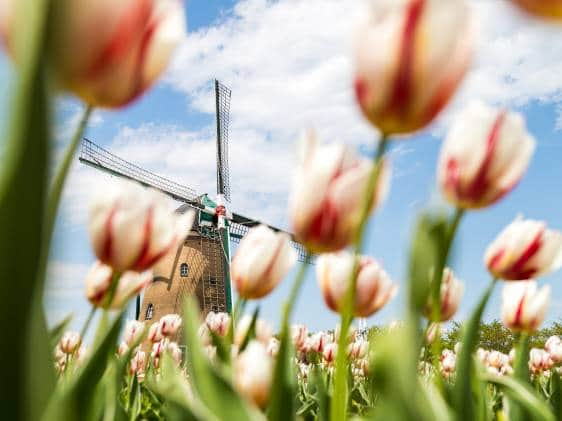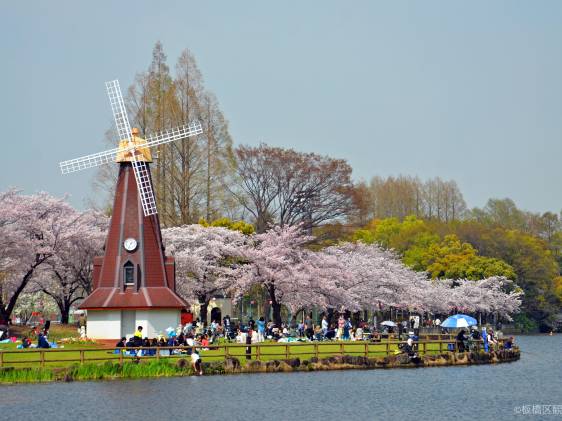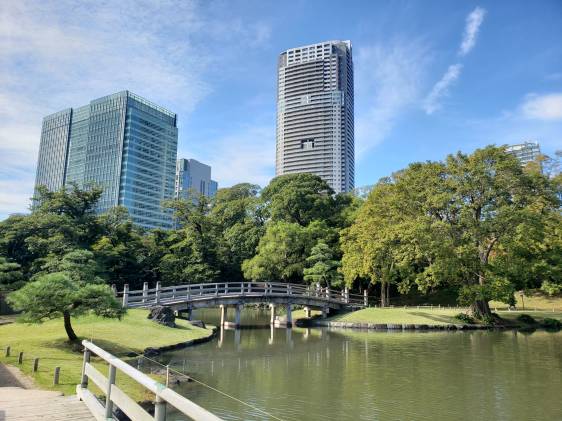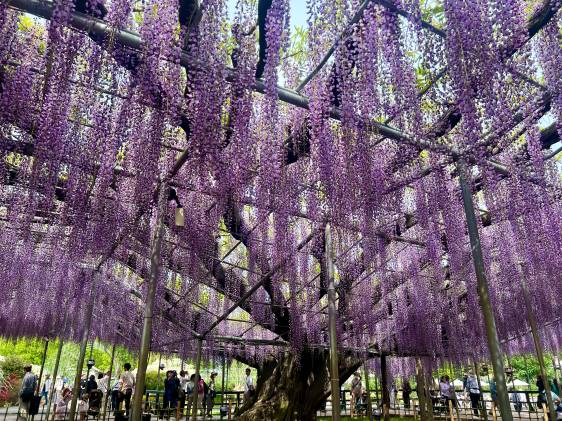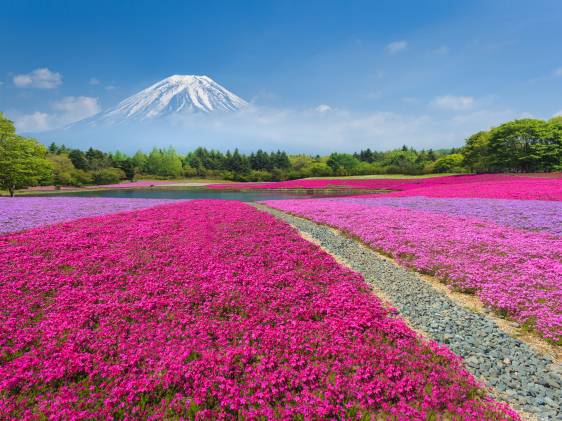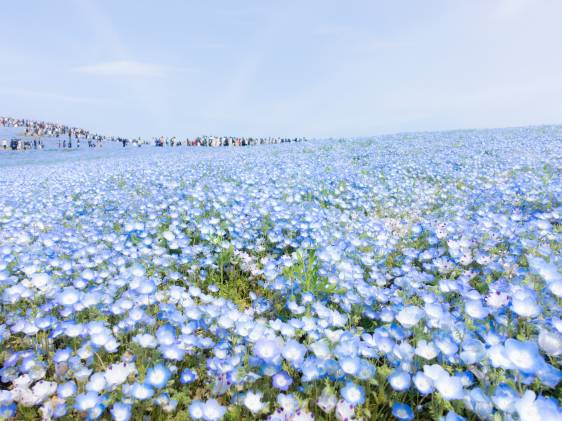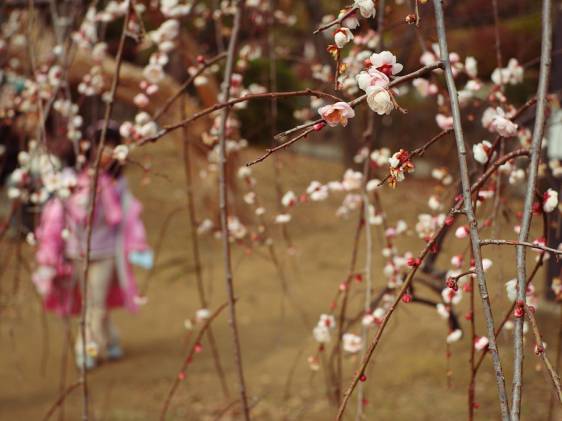Japan loves its flowers. Cherry blossoms, peonies, and chrysanthemums are particularly prevalent in Japanese art and crafts. No matter the month you come to Tokyo, there will be flowers in bloom — even in the middle of winter.
Here is a guide for what flowers bloom when, what they symbolize, and where to see them, for a full dose of flower appreciation at any time of the year.
Pro tip: Check out our top fall flower festivals and the best spring flower festivals in and around Tokyo.
Spring flowers in Tokyo
Without a doubt, spring is the best season to see something beautiful in bloom. The most beloved of them all — cherry blossom — turns the whole capital cotton-candy pink.
April brings fields of eye-popping yellow canola to offer, before wisteria and colorful moss make their entrances. Finally, baby blue eyes close out spring with relaxing hues of blue.
Cherry blossoms in March

Prepare yourself to be blown away by a storm of pink petals. The whole capital goes crazy come late March. Cherry blossoms (sakura) represent springtime and symbolize fleeting beauty and the brevity of life. The spectacle lasts for about two weeks until early April. Mind you, it is peak travel season, so expect airfares to go up and crowds everywhere. It is best to visit cherry blossom spots on weekdays if possible.
Pro tip: Bookmark this forecast map of sakura dates (updated yearly).
If you’re here in early March, then you may catch a special type of early blooming cherry blossom called Kawazu-zakura. The blooms are darker than the typical Somei Yoshino variety you’ll find at the end of March, but they last longer.
Where to see cherry blossoms in Tokyo
This list of 25+ awesome spots to see cherry blossoms in Tokyo is a must-read, as well as our guide to cherry blossom festivals and nighttime sakura spots.
But we’ve highlighted a couple of our favorite cherry blossom spots below.
Some of the most beautiful varieties can be viewed in Shinjuku Gyoen, a stunning royal Japanese garden with centuries of history. From weeping sakura to large, deep-pink blossoms, you can set up your tarp on the vast lawn for a picnic and let the marveling begin. No alcohol is allowed inside.
Students: ¥250
Seniors: ¥250
Chidorigafuchi Park, next to the Imperial Palace, lets you row a boat along the moat under cherry blossom trees for a memory that will likely last a lifetime. Waiting times for boat rental on the weekend are brutal, so schedule this for a weekday. The trees are illuminated at night during the Chiyoda Cherry Blossom Festival, and their reflection on the water is truly magical.
Tulips in April

You’ll be able to spot many Dutch-inspired tulip gardens in Tokyo at the end of March, going into April. These flowers are planted in reds, yellows, and purples and coincide with cherry blossom season — although tulips last for much longer. Consider heading to Nagasaki in Kyūshū for the king of tulip festivals in Japan.
Where to see tulips in Tokyo
A lot of space is needed to cultivate a colorful carpet of tulips, and so visiting Sakura City in Chiba is your best bet near Tokyo for finding the most — the Sakura Tulip Festival has over half a million flowers in bloom and features a windmill.
Another tulip spot that’s closer to Tokyo (also with the bonus of a windmill) is Ukima Park. Its Cherry Blossom and Tulip Festival sees the flowers light up at night and while it only has around 20,000 tulips, you can also see cherry blossoms.
Canola flowers in April

The end of the cherry blossom season can carry a bit of sadness as the last petals floating to the ground are associated with impermanence. But fret not, yellow, one of the most cheerful colors, is the hue of canola flowers (also known as rapeseed), and they bloom in abundance.
Where to see canola flowers
Hamarikyū Gardens in Shiodome has a large field of nanohana, the flower’s Japanese name, that makes for a great photo op.
If you really want to go for fields of gold, head over to Mother Farm in Chiba, Tokyo’s neighboring prefecture, where more than 3 million canola flowers bloom until mid-April.
Wisteria in May

Purple and blue are the hues of May in Japan. As the weather gets warmer, more and more flowers pop their dainty heads out. Wisteria, or fuji in Japanese, is associated with nobility and tends to show its crown from late April to early May.
Where to see wisteria in Tokyo
One of the most famous places to see wisteria is the festival at Kameido Tenjin Shrine in East Tokyo. There, you can also pick up lucky charms adorned with the flower. They are supposed to bring good fortune for studying and academics.
You can also go a little farther afield and visit the Ashikaga Great Wisteria Festival in Tochigi.
Shibazakura in May

Shibazakura, which means “cherry blossom moss” in Japanese, is a unique sight. It is known as moss phlox in English, and weekend excursions to see it are popular from mid-April to late May.
Where to see shibazakura in and around Tokyo
The best place to admire shibazakura is in Yamanashi Prefecture. See the flower against a backdrop of Mt. Fuji at the Fuji Shibazakura Festival at Fuji Motosuko Resort. About 800,000 plants in shades ranging from sky blue to pink to purple cover the ground. It is an easy day trip from Tokyo.
Another easy day trip from Tokyo to see shibazakura is the Chichibu Shibazakura Festival in Hitsujiyama Park. Around 400,000 plants cover four acres.
| At the door: ¥300 | ||
Baby blue eyes in May

Finally, how could you miss out on a flower called baby blue eyes? Also known as nemophila, it is a small, dainty plant that symbolizes victory and success and is often used to give congratulations. It blooms from late April to early May.
Where to see baby blue eyes in and around Tokyo
One of the best places to see baby blue eyes, not only in Japan but actually in the world, is Hitachi Seaside Park in Ibaraki. Here, marvel at an incredible 4.5 million plants that turn the slopes blue. Hitachi Seaside Park is a two-hour train ride from Tokyo — a bit of a trek to get to, but worth it. See more details in our event listing.
If you don’t want to travel too far, head over to Shōwa Memorial Park on the outskirts of Tokyo for a smaller field of nemophila in bloom.
Seniors: ¥210
Summer flowers in Tokyo
Tokyo’s sweltering summers are accompanied by water-loving flowers that thrive in the sub-tropical feel that the rainy season brings. June kicks off with fluffy balls of hydrangea. Stunning varieties can be seen anywhere from temples to the side of the train tracks.
In July, the rain fades and the temperature rises, giving way to lotus blooms on Tokyo’s ponds. Finally, frolic in fields of sunflowers around the capital in the summer heat of August.
Hydrangeas in June

Hydrangeas, called ajisai in Japanese, ring in the beginning of summer. Their colors can range from white, blue, pink, and purple. The flowers bloom in an astonishing variety of shapes and are associated with both apologies and gratitude.
Where to see hydrangeas in and around Tokyo
After cherry blossoms, this is probably the most popular flower that the locals swarm to see in bloom from early June to mid-July. Expect viewing spots to be crowded, especially on weekends.
One of our favorites is Hakusan Shrine in Bunkyo Ward, which boasts many varieties and colors within a relatively small area. There is an annual Ajisai Festival held every June with food stalls and the like.
Another spot is Hasedera Temple in neighboring Kamakura. Besides beautiful hydrangea, you also get a magnificent view of the ocean at the same time. The famous path usually requires advance reservations.
Lotus in July

The lotus flower, ren in Japanese, is rich in meaning and culture. It is the symbol of the Lotus Sutra, which contains the most important teachings of Nichiren Buddhism (the main school of the religion in Japan). As the beautiful flower grows out of mud, it is associated with patience, purity, mysticism, enlightenment, and rising out of suffering.
Where to see lotus flowers in Tokyo
The best place to see them in Tokyo is Shinobazu Pond in Ueno Park. They are in bloom from late July to mid-August.
Sunflowers in August

Although not native to Japan, sunflowers were introduced from the Americas centuries ago and are associated with radiance in Japanese culture. Fields of sunflowers brighten up the Japanese countryside in August across the country. But you don’t even have to venture out of Tokyo to see the most cheerful of all flowers.
Where to see sunflowers in Tokyo
The town of Kiyose on the border of Saitama Prefecture, about an hour from central Tokyo, holds an annual sunflower festival in mid-August where you can stroll through fields of more than 100,000 flowers.
Autumn flowers in Tokyo
Autumn is often claimed to be the best and favorite season of Japan. In addition to its culinary highlights, this season is blessed with sophisticated and intriguing varieties of flowers springing up.
In September, dainty cosmos are in bloom, and contrasted by dramatic spider lilies. Chrysanthemum exhibitions are held in October at many prominent gardens and temples. Finally, in November, there are leaves changing to fiery, golden hues. And don’t miss the big, round blossoms of the peony, one of the quintessential Japanese flowers.
Cosmos in September

Cosmos are sometimes also called “autumn sakura”; as such, they symbolize the beginning of fall. They start blooming in early September, sometimes late August, and fade in October.
Where to see cosmos in Tokyo
You can see an impressive 5.5 million flowers swaying in the cool autumn breeze at Showa Memorial Park across over 22,000 square meters of cosmos fields. Check the park’s website for the exact dates for each year.
Spider lilies in September

Another impressive flower making its appearance during this season is the bright-red spider lily. It looks much better than its name sounds, but the flower is associated with final goodbyes and is said to grow where people part ways forever. They bloom from mid- to late September.
Where to see spider lilies near Tokyo
The absolutely best place to see them are the Kinchakuda fields in Hidaka, Saitama, a day trip from central Tokyo.
| At the door: ¥500 | ||
Chrysanthemums in October

Chrysanthemum is the flower of the Japanese Imperial Family and is hence associated with nobility and purity. Kiku, as they are called in Japanese, bloom in November in an astonishing variety of colors, sizes, and shapes.
Where to see chrysanthemums in Tokyo
One of the best places to see them is the annual chrysanthemum exhibition in Shinjuku Gyoen that has been held for 90 consecutive years. The flowers are arranged in incredible displays in little huts that are erected throughout the park to protect them from the autumn weather for the duration of the event.
| At the door: ¥500 | ||
| At the door: ¥250 | ||
Winter peonies in November

Winter peonies bloom from late November up to January in some places. The large, colorful blossoms signify honor, prosperity, and good fortune.
Where to see winter peonies in Tokyo
Hamarikyu Gardens and Toshogu Shrine in Ueno Park are good places to see them.
Winter flowers in Tokyo
Winter is cold. It gets dark early, the leaves have fallen, and it all looks a bit lifeless. But keep your eyes peeled for camellia blossoms. Coming in stark red or other warm hues, these flowers can brighten your day if you spot them during your daily travels.
If you need a full-on flower fix, there are even daffodil fields to prove to you that not everything has died.
Camellia blossoms in December

Camellia japonica, or tsubaki in Japanese, is a flower of rich history. To samurai and warriors, the red camellia symbolized a noble death. Other meanings include humility as well as pure and perfect love. In English, it is also known as the rose of winter, as it is often the only bloom you can see in the coldest months.
Where to see camellia blossoms in Tokyo
While no gardens or parks are holding a special celebration for them, both the Imperial Palace Gardens and Shinjuku Gyoen are good spots to see them bloom in December, January, and often until mid-February. Also, keep your eyes open when walking through the streets of Tokyo, you will see them adorn many private gardens.
Daffodils in January

January is the coldest time of year in Tokyo, but daffodils add a little light to the dark. They start blooming in late January and are usually in full bloom by early February.
Where to see daffodils in Tokyo
Kasai Rinkai Park brightens the short winter days with over 200,000 daffodils planted in the park.
Plum blossoms in February

Japanese plum blossom, the cherry blossom’s sophisticated and more modest sibling, is a closer relative to the apricot tree. Known as ume in Japanese, these flowers bloom from mid-February to mid-March and are associated with elegance and loyalty.
Where to see plum blossoms in Tokyo
Take a look at our complete guide on where to see plum blossoms in Tokyo, including festivals and parks.
Hamarikyu Gardens in Shiodome has a variety of different plum trees, and Hanegi Park in Umegaoka (which means “plum blossom hill”) is one of the most popular spots for plum blossoms in Tokyo.
If you are willing to travel a bit farther out, the Plum Blossom Festival in Odawara is really worth a trip to see a grove of more than 30,000 plum trees against a backdrop of Mt. Fuji. It doesn’t get any more Japanese than that.
Even farther still in Atami (a popular day trip spot from Tokyo) is a famous plum blossom garden with pink and white blossoms. They also have early blooming cherry blossoms at around the same time.
While we do our best to make sure it’s correct, information is subject to change. Post first published in August 2020. Last updated in July 2025.
Get our Tokyo Cheapo Hacks direct to your inbox
-
 Tokyo’s Best Apartment-Style Hotels, by Area
Tokyo’s Best Apartment-Style Hotels, by Area -
 Highway to Hot Springs: Tokyo to Kusatsu Onsen by Bus
Highway to Hot Springs: Tokyo to Kusatsu Onsen by Bus -
 The Best Pocket Wi-Fi for Visiting Japan — Compared
The Best Pocket Wi-Fi for Visiting Japan — Compared -
 Go-Karting in Tokyo: Everything You Need To Know
Go-Karting in Tokyo: Everything You Need To Know -
 Morning Sumo Practice in Tokyo—Everything You Need To Know
Morning Sumo Practice in Tokyo—Everything You Need To Know -
 First-Time Harajuku Itinerary: Fashion, Street Food, and More
First-Time Harajuku Itinerary: Fashion, Street Food, and More
Recommended hotels located nearby
-
Shimokitazawa 25.5 km
-
Hatsudai 25.6 km
-
Ōme 15.1 km
-
Ekoda 25.1 km




